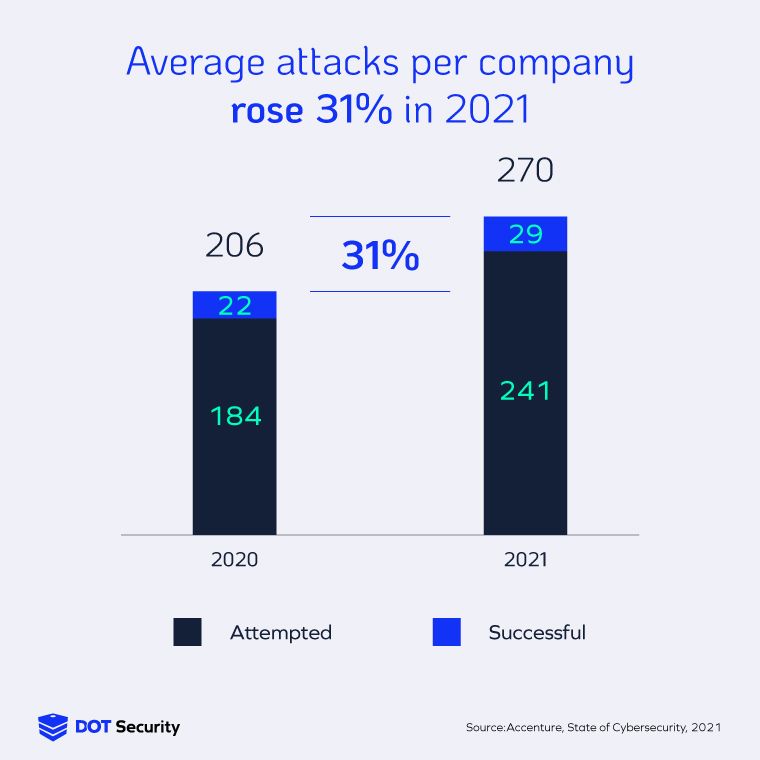Cybersecurity Consulting
7 Cybersecurity Trends In 2021
January 20, 2022
6 minutes

2021 was another big year of growth and innovation in cybersecurity, with businesses balancing pandemic difficulties, unique working situations, and a greater threat from cyberattacks than ever before.
Many of these trends stemmed from businesses relying more on digital solutions like cloud storage, remote access, AI, and Internet of Things (IoT) tech.
Sign up for our newsletter!
Read on to dive deeper into each trend, how it affected businesses, and what we will be looking out for in the coming years.
Artificial Intelligence (AI) in Cybersecurity
Thanks to the volume of cyberthreats and the continuing adaptation and changing nature of attacks, it’s become significantly harder for more traditional methods of antivirus to monitor behavioral anomalies in networks.
To help, businesses are integrating AI into their cybersecurity strategies to help spot cyberthreats because AI can establish and identify trends that make uncommon threats more obvious.
In short, artificial intelligence can be used to identify threats that may otherwise be hidden from view for network administrators—indeed, many organizations fail to spot cyberattacks until months after being breached simply because they lack tools like AI in their solutions necessary to do so.
A report indicates that organizations take an average of six months to detect a data breach in their network.
AI in cybersecurity also provides new ways to secure a network like facial recognition and language processing.
Whether it’s watching huge amounts of data, entry points, and devices, or helping a smaller team that processes significant or sensitive data sets in their network, AI is a useful tool to have for organizations of any size in today’s cybersecurity environment.
Multi-Factor Authentication and Password Security
Password management is a more significant trend for companies today than it has ever been.
This is because many businesses today lack adequate access controls for their cloud solutions, and with more investment in third-party apps and storage than ever, more data is being store in an unsecured manner.
This is something that is frequently catching out companies of all sizes, and we recommend seeing our infographic regarding the biggest breaches of 2021 to learn more about how poor access controls can lead to devasting cyberattacks.
Related Post: The Biggest Cybersecurity Breaches In 2021
61% of breaches involved stolen credentials.
To stay secure, organization-wide password protocols are a must.
This includes secure password storage software, automated password changes or notifications, password creation rules, access controls, and multi-factor authentication.
Even More Malware
As cybersecurity innovates and adapts, so do the hackers who are constantly finding new ways to penetrate networks through unique attack vectors.
As a result, the amount of malware that is being sent to victims has risen significantly.
Since the COVID pandemic began, fileless malware attacks have increased by 900%.
One type of malware which saw a big rise in volume in 2021 was ransomware, mostly due to its focus on financial gains possible from this form of attack.
As organizations increasingly turn to insurance providers to protect against losses from ransomware, hackers have invested more heavily in these attacks, and since the pandemic there has been a third more ransomware families of malware in operation.
An estimated 500,000 new pieces of malware are detected every day.
As the pandemic and the rise of remote work and digitization becomes commonplace, ransomware campaigns against businesses and users have increased in turn and now represent a major attack vector for organizations to protect against.
Ransomware occurs when a hacker steals and encrypts data so it’s unusable until a ransom is paid. For businesses in industries like finance or healthcare that frequently deal with sensitive information (PII and PHI), this can be devastating to both the business and the customers who rely on it.
As with most cyberattacks, most successful ransomware attacks begin with people and their susceptibility to social engineering attacks, which brings even more importance to proper cybersecurity education and awareness.

Cybersecurity for the Cloud
2021 was a boon for cloud storage solutions, with 94% of enterprises now using cloud services in some way.
Businesses are continuing to see the benefits of storing their data on the cloud—which allows them to leverage that information for the purposes of data analysis while simultaneously improving flexibility by offering remote work capabilities.
While the benefits of shifting to the cloud are undoubted, it has led to a situation in which many companies are operating with inadequate cybersecurity standards and policies necessary to protect data stored in the cloud.
Cybersecurity Awareness Training and More Social Engineering Attacks
Cybersecurity awareness training and education on best practices has become a crucial element of a complete cybersecurity strategy to help workers understand where cyberattacks are coming from, what they look like, and how to avoid them.
85% of cybersecurity breaches in 2021 involved a human element or error, meaning that the main way attackers are infiltrating business networks is through their employees.
This kind of awareness training will typically involve educating staff on what real-world social engineering attacks look like—for example sending fake phishing emails designed to emulate real attacks in order to test the workforce’s capability to defend against threats and highlighting potential attack vectors that present a weakness.
Social engineering attacks—a kind of cyberattack which targets humans—are becoming more sophisticated and more difficult to identify.
Though most spam filters do a good job of filtering out some of these, they never get them all and it only takes one click to open a business to hackers.
These social engineering attacks, commonly known as phishing, come in many shapes and forms, most known in emails but now becoming more prominent in texting, phone calls, and social media.
2021 saw a rise in business’ focus on education and making cybersecurity best practices common knowledge within their teams in order to prevent their employees falling victim to attack.
Growing Importance of Endpoint Security
More remote employees and digital processes naturally leads businesses to having more devices, equipment, and endpoints that present vectors for potential breaches.
People who work remotely from phones and laptops need to understand the risk they take when they connect to public Wi-Fi networks or even their home network.
To protect remote workers and their devices, businesses must themselves take the necessary precautions to ensure proper protection—adding layers of solutions to their processes like access controls, authentication, secure password management, and mobile device management for monitoring.
Internet of Things (IoT) Expansion
As a business’ IoT profile expands and grows, it creates even more chances for hackers to infiltrate a network.
This is because more endpoints, as we have noted, leads to a greater attack surface, which represents a greater threat to the business.
From January to June 2021, 1.51 billion breaches of Internet of Things (IoT) devices took place, Kaspersky reported, an increase from 639 million in 2020.
These new vulnerabilities must be secured and in 2021 we saw a new focus on security for IoT devices and equipment.
To secure IoT devices, businesses must focus on password security, access controls, and network monitoring to ensure nobody is misusing devices and to identify irregularities when they appear.
Aligning Cybersecurity with Business Goals
New studies have found the connection between successful cybersecurity, how closely it is aligned with business goals, and the extent to which it is considered in major initiatives.
A “cyber champion”—a term used to refer to organizations that take a leading role in their cybersecurity strategy—gets the most out of their cybersecurity program, stops more attacks, finds breaches faster, remediates breaches faster, and reduces the overall impact of those breaches by including cybersecurity in decision making.
Businesses must focus on not creating security silos and collaborate with their cybersecurity team to create a plan that understands business risks and priorities.
This is the only way to truly cover up vulnerabilities which helps in all aspects of security.
Businesses who focus more on business-related priorities without considering security are victims of attacks with a 53% success rate, 23% of which will result in significant harm, compared to a 17% success rate for businesses who take a cyber champion approach.
Bottom Line
2021 saw a big increase in the importance of cybersecurity and in protecting remote workers and digitally stored information.
The significance of these trends looks to continue growing in 2022, making it crucial for businesses to begin tackling these problems as soon as possible or risk falling victim to devastating data breaches.
If you’re ready to learn more about how you can implement the security measures mentioned in the trends above, contact DOT Security and speak with an expert today.
